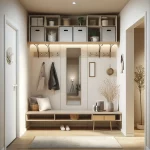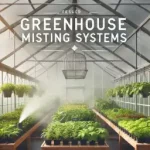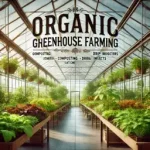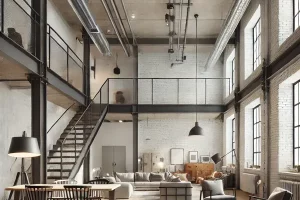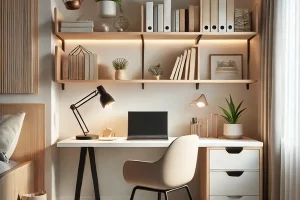Year-round greenhouse gardening is a way to grow plants inside a greenhouse all year. Unlike regular gardening, which depends on the seasons, greenhouse gardening lets you control the environment. This means you can grow plants even in winter or bad weather.
There are many important benefits of year-round greenhouse gardening. It extends the growing season so you can have fresh vegetables, fruits, herbs, and flowers no matter the weather. Greenhouses protect plants from pests and diseases and protect them from extreme weather. They also let you try growing different plants that need to do better outside.
When starting with year-round greenhouse gardening, there are some key things to consider. Keeping the right temperature is very important for plants to grow well.
Benefits of Year-round Greenhouse Gardening
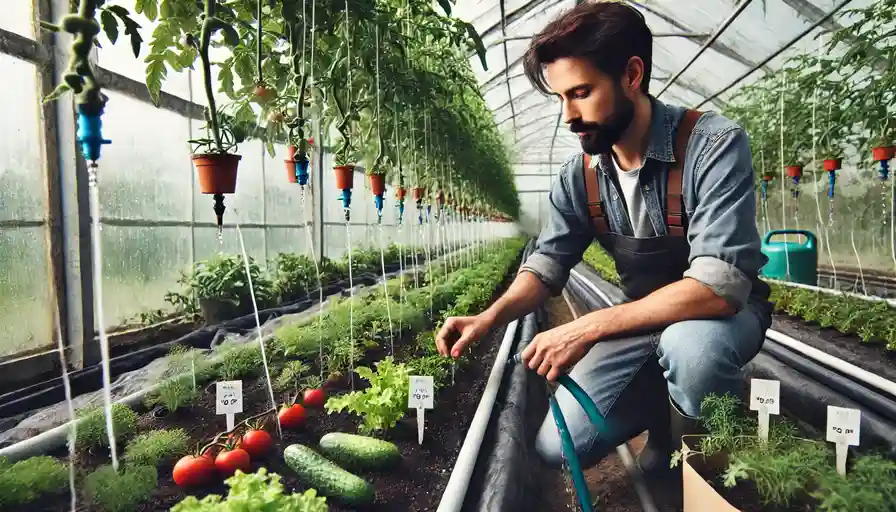
Growing Season All Year
One big benefit of having a greenhouse is you can grow plants all year. Even in winter, your plants stay warm and happy inside the greenhouse. This means you can eat fresh veggies and see pretty flowers anytime.
More Plant Choices
A greenhouse allows you to grow many different plants. Some plants need special care, and a greenhouse can provide the right conditions. This means you can try growing exotic plants that might not do well outside in your area.
Protection from Weather
A greenhouse keeps your plants safe from bad weather. Wind, rain, snow, and too much sun can hurt plants. Inside the greenhouse, they are protected from these harsh conditions. Your plants will be healthier and grow better.
Fewer Pests and Diseases
Pests and diseases can be a big problem for gardeners. In a greenhouse, it’s easier to keep pests away. You can also control diseases better. This means your plants will be healthier, and you won’t have to use as many chemicals.
Better Plant Growth
In a greenhouse, you can control the temperature, light, and water. This helps plants grow better. They get just the right amount of everything they need, which means bigger, healthier plants and more fruits and flowers.
Save Money
Growing your fruits, veggies, and herbs can save you money. You won’t have to buy these items at the store. Plus, you know they are fresh and free from chemicals.
Types of Plants for Year-round Greenhouse Gardening
Vegetables
Many vegetables grow well in a greenhouse, including tomatoes, lettuce, cucumbers, and peppers. Even in winter, these plants can thrive in a warm, controlled environment.
Fruits
You can also grow fruits in a greenhouse. Strawberries, lemons, and oranges do well. They need lots of light and warmth, which a greenhouse can provide. You can enjoy fresh fruit all year long.
Herbs
Herbs are great for a greenhouse. Basil, mint, and parsley grow quickly. They don’t need much space, so you can grow many different kinds of plants. Fresh herbs make your meals tastier and are easy to grow.
Flowers
A greenhouse is perfect for flowers. Orchids, roses, and poinsettias do very well. Flowers make your greenhouse look beautiful and can be a fun hobby. You can also grow flowers to give as gifts or to sell.
Special Plants
Some plants need special care that a greenhouse can provide. You can grow exotic plants like cacti, succulents, and tropical plants. These plants might not survive outside, but in a greenhouse, they can thrive.
Temperature Control in a Greenhouse
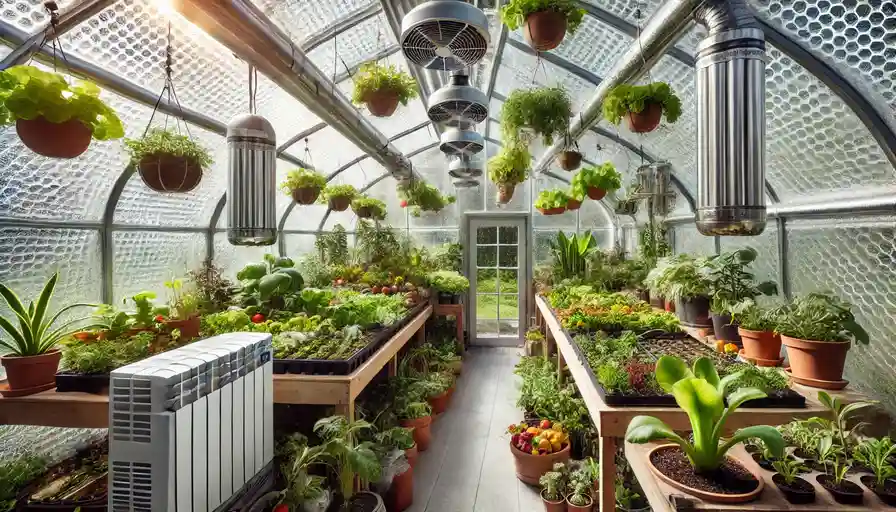
Why Temperature is Important
Plants need the right temperature to grow well. They will only be happy if it’s hot or cold. You can control the temperature in a greenhouse to ensure your plants stay healthy.
Heaters for Winter
In winter, it can get very cold. A heater in your greenhouse keeps the temperature warm enough for your plants. There are different types of heaters, like electric or gas heaters. You can choose the one that works best for your greenhouse.
Fans for Summer
In summer, the greenhouse can get too hot. Fans help cool the air. They move the hot air out and bring in fresh air, keeping the temperature just right for your plants.
Insulation
Insulation helps keep the temperature steady. It keeps the warm air inside in winter and the hot air out in summer. You can use bubble wrap or special greenhouse insulation to cover the walls and roof.
Thermometers
A thermometer helps you check the temperature inside your greenhouse. You can see if it’s too hot or too cold and make adjustments. Some thermometers even show the humidity, which is important for plant growth.
Automatic Systems
Automatic systems can control your temperature. They can turn the heater or fan on and off when needed, making it easier to maintain the right temperature at all times.
Essential Tools for Year-round Greenhouse Gardening
Thermometers and Hygrometers
Thermometers help you check the temperature, and hygrometers measure humidity. Both are important for keeping your greenhouse environment just right for your plants.
Watering Systems
Watering systems like drip irrigation or sprinklers ensure your plants get enough water. They can be set to water your plants at the right times, so you don’t have to do it by hand daily.
Garden Tools
Basic garden tools like pruners, trowels, and gloves are important. Pruners help you trim plants, while trowels are great for digging and planting. Gloves protect your hands while you work.
Pest Control
Sticky traps and organic sprays help control pests. Sticky traps catch flying insects, and organic sprays are safe to use on plants and can help keep pests away.
Lighting
Grow lights are important, especially in winter with less natural light. LED and fluorescent lights are good choices. They help your plants grow even when it’s dark outside.
Plant Supports
Some plants need support to grow well. Stakes, cages, and trellises help keep plants upright. They are especially useful for tall or vine-like plants.
Pest Management in a Year-round Greenhouse
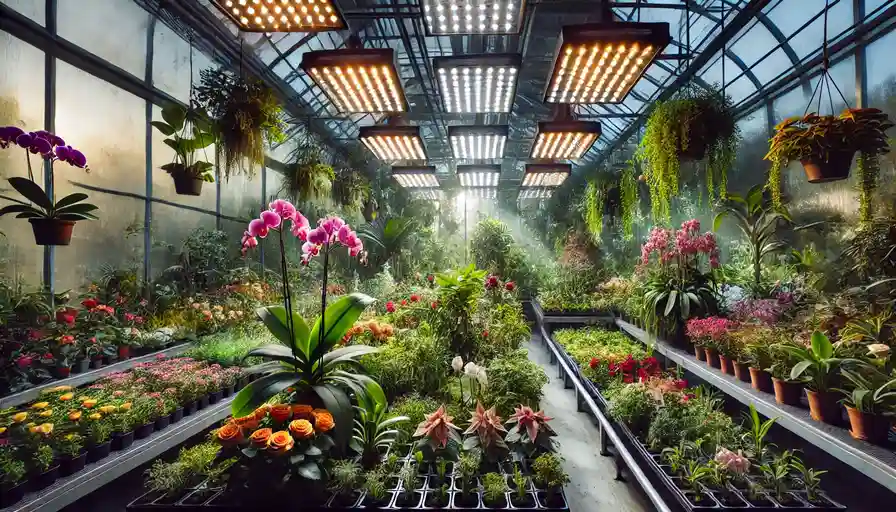
Common Pests
Some common pests in greenhouses are aphids, whiteflies, and spider mites. These pests can harm your plants by sucking their juices or spreading diseases.
Preventive Measures
To prevent pests, keep your greenhouse clean. Remove dead leaves and plants that can attract pests. Check your plants regularly for signs of pests. Healthy plants are less likely to have pest problems.
Natural Pest Control
Ladybugs and other beneficial insects can help control pests naturally. They eat harmful insects like aphids. You can buy these beneficial insects and release them in your greenhouse.
Organic Sprays
Organic sprays are safe for your plants and the environment. They can help get rid of pests without using harsh chemicals. Neem oil is a popular organic spray that works well.
Sticky Traps
Sticky traps catch flying insects like whiteflies. Hang them near your plants to trap these pests. They are easy to use and can help reduce pest numbers.
Regular Checks
Check your plants regularly for pests. Look under the leaves and on the stems. The sooner you find pests, the easier it is to control them. Remove any pests you find by hand or with a spray.
Lighting for Year-round Greenhouse Gardening
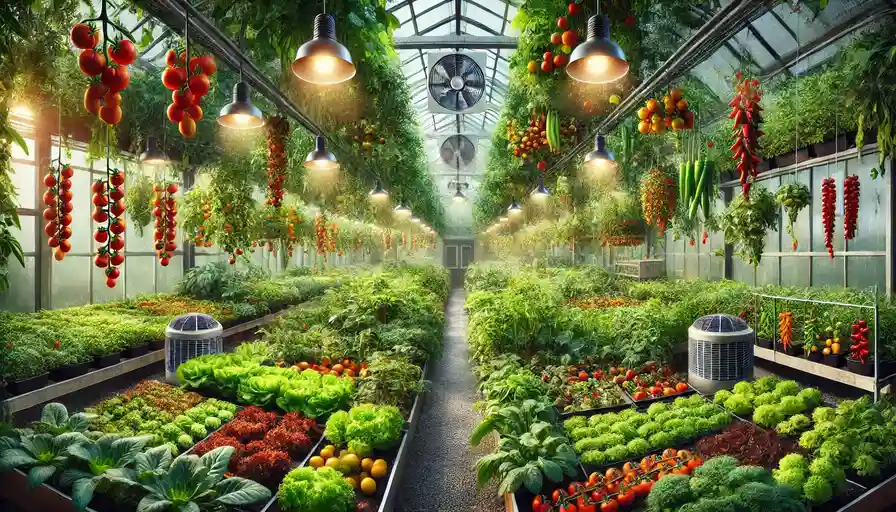
Why Lighting is Important
Plants need light to grow. There might need to be more natural light in a greenhouse, especially in winter. Grow lights help plants get the light they need to stay healthy.
Types of Grow Lights
There are different types of grow lights you can use:
- LED Lights: These are very energy-efficient and last a long time. They don’t get too hot, so they’re safe for your plants.
- Fluorescent Lights: These lights are good for growing seedlings and leafy greens. They use less energy than some other lights.
- High-Intensity Discharge (HID) Lights: These are powerful and good for big plants. They can get hot, so you need to be careful.
Placing the Lights
Ensure your grow lights are close enough to your plants but not too close. If the lights are too far away, your plants won’t get enough light, and if they’re too close, the plants could get too hot. Adjust the height of the lights as your plants grow.
Timing the Lights
Plants need a certain amount of light each day. You should leave the grow lights on for longer in winter. A timer can help you turn the lights on and off at the right times.
Watering Plants in a Year-round Greenhouse
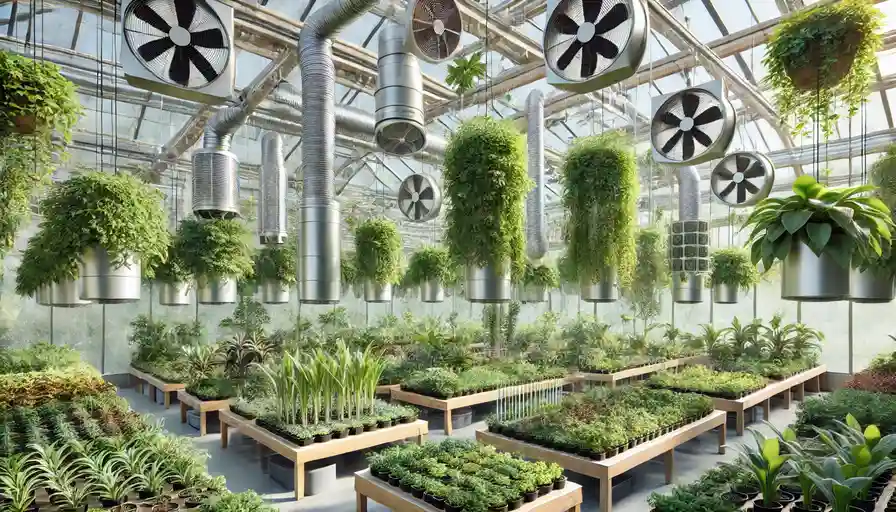
Water is essential for plant growth. In a greenhouse, it’s important to water your plants the right way. Too much or too little water can harm your plants.
Best Practices for Watering
- Check the Soil: Before watering, check if the soil is dry. Stick your finger into the soil up to your first knuckle. If it’s dry, it’s time to water.
- Water the Roots: Pour water at the base of the plants, not on the leaves. This helps the roots absorb the water they need.
Watering Systems
- Drip Irrigation: This system drips water slowly to the roots of the plants. It’s very efficient and saves water.
- Sprinklers: These can water a large area at once. Ensure they’re set to water the base of the plants, not the leaves.
- Hand Watering: Water your plants by hand using a watering can. This gives you control over how much water each plant gets.
How Often to Water
How often you water depends on the type of plant and the season. In summer, plants might need more water, and in winter, they might need less. Always check the soil to see if it’s dry before watering.
Best Greenhouse Structures for Year-round Gardening
Types of Greenhouse Structures
There are different types of greenhouses you can use for year-round gardening:
- Freestanding Greenhouses: These are not attached to any building. They can be placed anywhere in your yard. They come in many sizes, so you can choose one that fits your space.
- Lean-to Greenhouses: These are attached to one side of a building. They share a wall with the building, which can help with heating. They are good if you have limited space.
Materials for Greenhouses
- Glass: Glass greenhouses look nice and let in a lot of light. They can be more expensive and fragile.
- Polycarbonate: This is a strong, lightweight plastic. It’s cheaper than glass and very durable. It also provides good insulation.
- Plastic Film: This is the least expensive option. It’s easy to install but not as durable as glass or polycarbonate.
Choosing the Right Size
When choosing a greenhouse, consider how many plants you want to grow. Ensure enough space for all your plants to get enough light and air. It’s better to have a greenhouse that’s a little too big than one that’s too small.
Location of the Greenhouse
Place your greenhouse where it will get the most sunlight. A south-facing spot is usually best. Make sure it’s easy to reach and has access to water and electricity.
Ensuring Proper Ventilation in a Greenhouse
Why Ventilation is Important
Ventilation is important because it helps plants breathe. Fresh air helps keep plants healthy by providing them with the carbon dioxide they need to grow. Good ventilation also helps control temperature and humidity.
Types of Ventilation
- Natural Ventilation: This is the simplest way to ventilate your greenhouse. Open windows, doors, or vents to let fresh and hot air in. This works well in mild weather.
- Mechanical Ventilation: Fans move air in and out of the greenhouse. They can be set up to automatically turn on when it gets too hot or humid inside, which is useful in all kinds of weather.
Using Vents and Fans
- Roof Vents: These vents let hot air escape from the top of the greenhouse. Since hot air rises, roof vents effectively cool the greenhouse.
- Side Vents: These vents allow fresh air from the sides. Opening side vents on a cool day can help bring in fresh air without making the greenhouse too cold.
- Circulation Fans: These fans help move air around inside the greenhouse. They prevent hot spots and make sure all plants get fresh air.
Automatic Systems
Automatic ventilation systems can help keep the temperature and humidity at the right levels. They can open and close vents or turn fans on and off, making it easier to maintain a healthy environment for plants.
Common Challenges and Solutions
Extreme Weather
- Problem: Very hot or very cold weather can harm your plants.
- Solution: Control the temperature by using heaters in winter and fans in summer. Insulate your greenhouse to keep the temperature stable. Use shade cloths to protect plants from too much sun.
Pests and Diseases
- Problem: Pests and diseases can damage your plants.
- Solution: Keep your greenhouse clean. Check plants regularly for signs of pests or diseases. Use natural predators, like ladybugs, to control pests. Remove any infected plants to prevent the spread of disease.
Watering Issues
- Problem: Overwatering or underwatering can harm plants.
- Solution: Check the soil before watering. Use a drip irrigation system to provide consistent water. Make sure your greenhouse has good drainage to prevent water from pooling.
Poor Ventilation
- Problem: Poor ventilation can lead to mold, mildew, and poor plant growth.
- Solution: Use vents and fans to ensure good airflow. Check the temperature and humidity regularly. On mild days, open doors and windows to let fresh air in.
Nutrient Deficiencies
- Problem: Plants may need more nutrients from the soil.
- Solution: Use high-quality soil and fertilizers. Check your plants for signs of nutrient deficiencies, like yellow leaves. Add compost or organic matter to the soil to improve its quality.
Managing Light
- Problem: Not enough light can make plants weak. Too much light can burn them.
- Solution: Use grow lights to provide extra light in winter, shade cloths to protect plants from too much sun in summer, and adjust the position of your plants so they get the right amount of light.
Year-round greenhouse gardening is rewarding. With the right tools and techniques, you can enjoy fresh produce and beautiful plants all year. Start small, and soon you’ll see the benefits. Happy gardening!



